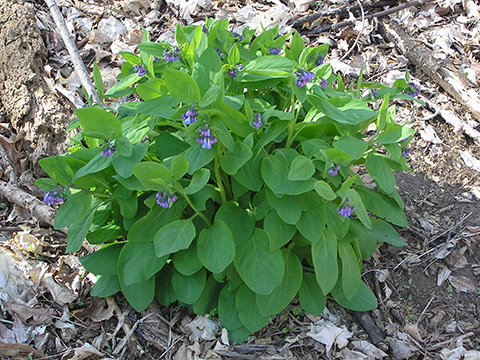 |
| Home | Ordering By Mail | Purchase Manual: Using Native Plants in Urban Landscapes |
|
|||||
Species Name: Mertensia virginica
Common Name: Virginia bluebells
Zone: 3 to 9
Distribution: Quebec and Ontario south to Georgia and Alabama.
Seed collection: Virginia bluebells (VB) begin flowering in early April in NY. Flowering and growth is well underway before the canopy trees begin to leaf out in mid-May giving VB ample time to photosynthesize and store energy in its woody root. Virginia bluebell completes its life cycle and disperses its seed in late May early June and quickly goes dormant.
The seed develops at the base of the flowers inside the calyx forming an inverted cup with four small hard seeds in each. The seed changes color from green to light brown and then black as it matures. The seed from individual flowers matures at the same rate as the opening and pollination of the flowers so some seed may be dispersing as others are just changing color. It is safer to collect the seed before fully mature than to lose many seeds to early dispersal.
Seed handling: No special handling is required for the seed. Collect flower stalks as some of the seed is changing color but before seed is released, place seed in a paper bag for drying. After a few days shake the bag to release the seed. Place seed under moist stratification soon after collecting or sow seed directly where you would like the plants to grow.
Germination requirements: Seed planted immediately after collecting or stratified seed will germinate in high percentages the first spring. Germination is quick and seedling growth rapid. The seedlings develop a slender woody root that can be transplanted after the seedlings have gone dormant. Seedlings may begin flowering the second year from seed. Plants can also be divided by digging up and breaking apart the woody root while retaining some vegetative buds with each root piece.
Virginia bluebell also readily self sows and numerous seedlings will be found in and around established plants. These can be dug up and transplanted as they begin to go dormant.
Ecology: Virginia bluebell is a true spring ephemeral of flood plain forests and moist rich woodlands. It can be found by the acre in prime habitats carpeting the forest floor with a profusion of blue flowers. Each rootstock produces a mound of oval leaves topped by several clusters of bell shaped blue flowers.
Bluebells are commonly found growing in profusion along river courses and flood plains where flooding and sedimentation provides an ideal seedbed for seed deposition and germination and provide perfect growth conditions for bluebells. Bluebells complete their growth and reproductive cycle before most other plants have even begun to emerge and grow so it lacks few plant competitors and its foliage is highly deer resistant so high deer populations have little impact.
Bluebells provide a valuable early season nectar and pollen source for bumble bees and other bee species who also provide the service of pollinating the flowers.
Bluebells are easy to naturalize by collecting and dispersing seed or by transplanting dormant roots. Once a few plant are established these will function and seed reservoirs for further colonization. The woody roots of bluebells are long lived and will continue to flower year after year as the root system gets larger and under good conditions.

Clump of bluebells in flower.
this page posted January 6th, 2014